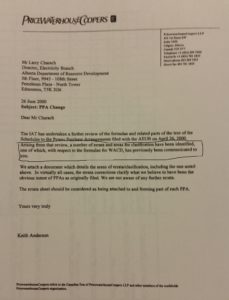Originally posted 16 August 2016
The de-regulation of electricity markets was a cornerstone policy of the Klein years. Recently the government has commenced legal proceedings to roll back a clause in the Power Purchase Agreements (PPAs) known as the “Enron clause.”
The government claims that the last minute insertion of the clause “or more unprofitable” was carried out without proper public debate and discussion.
It is perhaps under-stating the case that electricity de-regulation in Alberta is “complex”. Historically, electricity rates for both retail and commercial customers were set by the Alberta Utilities Board who determined what rate of return the electricity provider would receive. Underlying regulation was a concept that electricity was central to the well-being of citizens and business enterprises and a stable market supplying electricity was in the public interest. This attitude shifted during the 1980s with the Thatcher reforms in Britain’s electricity and telecommunications industries. A key concern revolved around both the willingness of utility firms to supply electricity and the availability of capital to finance new generation capacity.

De-regulation in Alberta resulted in the carving up of industry into three main parts: generation, transmission and distribution. Electricity prices would be set in open markets on a hour by hour basis under a system overseen by the Alberta Electricity System Operator. In order for generation to come on line, long-term PPAs were required to give assurance to creditors and investors in generation facilities that long-term contracts at agreed to pricing would support the huge investments necessary. The Balancing Pool was created in 1999 to “manage generation assets in a commercial manner, specifically any Power Purchase Arrangements (PPAs) held by the Balancing Pool that include the right to exchange electric energy and ancillary services, and any arrangements or agreements derived from these assets and to forecast revenues and expenses related to PPAs, to estimate the surplus or deficiency from the management of these contracts; and more generally to prudently manage risks of the systems operations.

Prominent economists Andrew Leach (Alberta School of Business) and Trevor Tombe (University of Calgary) waded into the PPA debate with the release of their 16-page study published by the UofC’s School of Public Policy.The economists dispute the “up to” $2 billion number given by the provincial government– a fact that attracted media attention.
The paper dis-aggregates the different sources for the $2 billion estimate into 3 segments while examining seven PPAs (Keephills, Sundance C, Sundance B, Sheerness, Genesee, Sundance A, and Battle River5). The first piece is a change in government policy resulting from changes to the Specified Gas Emitters Regulation (SGER) initiated in June 2015 – a key early initiative by the NDP government. (Specified emitters are those facilities which produce more than 100,000 tonnes of emissions or more in 2003.) This change increased the charge for emissions from $15 per tonne of Carbon dioxide to $20 in 2016 and to $30 in 2017.
The second government policy change took place in November 2015 after the release of the Climate Change Panel report, chaired by Andrew Leach.
After the Leach Report was tabled, the Government adopted the recommended Carbon Competitiveness Regulation (CCR). This change affected coal power generators, who, under the previous regime received “credits based on 88 per cent and 80 per cent respectively of their own historic emissions intensity for free in 2016 and 2017, and would only pay the carbon price on approximately 12 per cent, and subsequently 20 per cent, of their emissions.” (Leach and Tombe, p. 5). However, under the new CCR, coal-fired plants only received credit for one-third of their emissions, thus causing the cost of coal-fired generation to increase. Leach and Tombe calculate that the effect of the CCR increased the cost of a megawatt hour (MWh) of electricity by $15 per MWh after the June 2015 regime. Some of the coal -fired generators were advocating for an emissions cap and a cap and trade system and were therefore disappointed the Panel did not recommend this “mass-based” approach.
The third part of the determination of the market value of PPAs was the significant decline in power prices. Futures prices for electricity have fallen from about $55-$60 MWh in the summer of 2015 to $42-$48/MWh by July 2016. These prices however are considerably higher than current spot prices of less than $20/MWh. With this data, Leach and Tombe show the breakdown between the three factors driving the change in the market values for these seven PPAs. From a positive value of almost $1.5 billion last summer, these seven contracts are estimated to be worth about negative $900 million. Policy changes account for about half the change in value and market prices the other half.
So what is the big fuss. The economists note that Albertans benefit now from already low electricity prices. If prices remain low the balancing pool will absorb the losses and send the bill to the consumers. Should prices rise, the value of the PPAs would rise and the costs of the PPA termination to the Balancing Pool would fall reducing any charges to consumers. As far as the Enron clause is concerned, the authors observe that it” was unlikely the intent of original section 4.3(j) for PPA holders to avoid both policy-driven and market-based losses.”